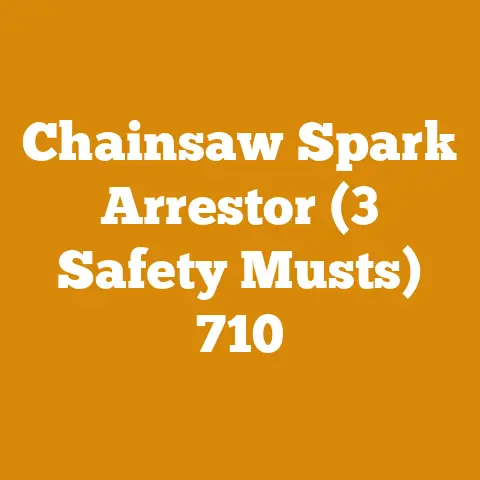Husqvarna Carb Adjustment Settings (3 Key Adjustments)
If you’ve ever felt the thrill of revving up a chainsaw and watching it slice through wood like a hot knife through butter, you know there’s more to it than meets the eye.
A well-tuned chainsaw is a lumberjack’s best friend, and today, I’m going to walk you through the art of adjusting the carburetor on your Husqvarna chainsaw.
So, grab a cup of coffee, and let’s dive into those three key adjustments.
Why Carb Adjustment Matters
Ever noticed your chainsaw bogging down or running rough?
The secret might just lie in those tiny carburetor screws.
Adjusting them can make a world of difference, giving you smoother cuts and better fuel efficiency.
It’s like tuning a fine instrument—get it right, and everything sings!
Personal Experience: The First Time I Adjusted a Carburetor
I remember the first time I tackled a carburetor adjustment.
It was early in my career as a lumberjack, and I was using an old Husqvarna 55.
The chainsaw was sputtering like an old car on its last legs.
A seasoned colleague showed me how to tweak the carburetor, and suddenly, that old saw roared back to life.
It was a moment that taught me the importance of understanding your tools.
Prerequisites and Required Materials
Before we get started, let’s make sure you’re prepared:
Prerequisite Knowledge
- Basic understanding of how a chainsaw operates.
- Familiarity with safety procedures when handling power tools.
Required Materials
- Husqvarna Chainsaw: Ensure it’s in good condition.
- Screwdriver: Usually a small flathead or specialized carburetor adjustment tool.
- Tachometer: Optional, but helpful for precise adjustments.
- Personal Protective Equipment (PPE): Gloves, goggles, ear protection.
Specialized Tools and Why They Matter
While many DIY enthusiasts might try to make do with whatever tools they have on hand, having the right equipment can make all the difference.
A specialized carburetor adjustment tool provides the precision needed to make minute adjustments without stripping the screws.
Trust me; it’s worth the investment.
Safety First!
Chainsaws are powerful tools, but they can be dangerous.
Always wear your PPE, work in a well-ventilated area, and keep a safe distance from bystanders.
Remember, safety isn’t just a guideline—it’s a rule.
Safety Story: A Close Call
Let me share a quick story about safety.
A friend of mine was adjusting his chainsaw without gloves, thinking it was just a quick tweak.
He slipped, and although it wasn’t serious, he ended up with a nasty cut on his hand.
It served as a stark reminder that safety gear isn’t optional—it’s essential.
The Three Key Adjustments
1. Low-Speed Adjustment (L Screw)
This one’s all about the engine’s performance at idle.
If your chainsaw stalls or runs rough at low speeds, this is where you need to focus.
Steps:
- Warm Up the Engine: Start the chainsaw and let it run for a few minutes.
- Locate the L Screw: Usually found on the side of the carburetor.
- Turn the L Screw Clockwise: Slowly turn until the engine begins to falter.
- Back Off Slightly: Turn counterclockwise until the engine runs smoothly at idle.
- Check Acceleration: Rev the engine; it should accelerate without hesitation.
In-Depth Insight: Understanding Engine Behavior
When adjusting the L screw, listen closely to the engine’s behavior.
If it hesitates before revving up or seems sluggish, you may need to fine-tune further.
It’s like adjusting the tension on a guitar string; each tiny tweak can change the sound dramatically.
2. High-Speed Adjustment (H Screw)
Need power? This adjustment controls how your chainsaw performs at full throttle.
Steps:
- Hold the Chainsaw Securely: Brace it on a stable surface.
- Locate the H Screw: Next to the L screw.
- Turn Clockwise to Lean: Go until the engine screams but doesn’t quite reach maximum RPM.
- Back Off Counterclockwise: Just enough for smooth operation without over-revving.
- Use a Tachometer: If available, consult your manual for RPM specs.
Real-World Example: The Importance of RPM
During my early days as a logger, I learned how critical it was to avoid over-revving my chainsaw.
Once, while cutting through a particularly tough oak, I pushed my saw too hard without proper adjustment.
It overheated and stalled mid-cut—an embarrassing lesson in why proper RPM settings matter!
3. Idle Speed Adjustment (T Screw)
This controls chain movement at idle.
Too fast, and it’s dangerous; too slow, and it stalls.
Steps:
- Locate the T Screw: Often near the top or side.
- Adjust Idle Speed: Turn clockwise to increase idle; counterclockwise to decrease.
- Ensure Chain Doesn’t Move: At idle, the chain should stay still.
Practical Tips: Fine-Tuning Idle Speed
Finding the perfect idle speed can be tricky.
If your chainsaw idles too high, it can be hard to control when starting cuts.
Too low, and it might stall when you least expect it—like when you’re balancing on a ladder!
Tips for Success
- Listen carefully—your ears are as valuable as any tool here.
- Take notes on adjustments so you can revert if needed.
- Use small turns; less is often more.
Best Practices from the Field
One trick I’ve picked up is marking the original positions of each screw with a dab of paint or nail polish.
That way, if you ever need to return to factory settings, you know exactly where to go.
Common Questions and Concerns
Why does my chainsaw stall?
It could be running too lean or rich. Adjusting the L screw may help.
How do I know if I’ve adjusted it correctly?
Listen for smooth transitions in speed and power without stalling or over-revving.
What if I don’t have a tachometer?
While it helps, your ear can usually tell you when things are right.
Troubleshooting Tips
- If you’re struggling with starting issues, check your fuel mix and spark plug.
- For persistent problems, consult a professional or refer to your manual.
Advanced Insights: Getting Technical
For those who want to dive deeper into the mechanics of carburetors, understanding air-to-fuel ratios can be fascinating.
While most homeowners won’t need this level of detail, knowing how these ratios affect combustion efficiency can give you an edge in troubleshooting complex issues.
The Science Behind Carburetors
A carburetor works by mixing air with fuel in just the right proportions for combustion in an internal combustion engine.
Too much air (lean) or too much fuel (rich) can cause problems ranging from poor performance to engine damage.
Conclusion and Next Steps
Adjusting your Husqvarna’s carburetor isn’t just about better performance—it’s about safety and efficiency too.
Keep these adjustments in mind next time you’re out in the field, and you’ll be making clean cuts in no time.
Looking Ahead: Routine Maintenance
Regular maintenance doesn’t stop with carburetor adjustments.
Keeping your chainsaw sharp, clean, and well-lubricated will ensure long-lasting performance and safety.
FAQ Section
How often should I adjust my carburetor?
Whenever you notice performance issues or after significant use.
Can I use these settings on other brands?
While similar principles apply, always consult the specific manual for your model.
Is there a risk of damaging the engine?
Yes, improper adjustment can harm the engine. Proceed with caution!
Additional Resources
For those interested in learning more or seeking professional advice, consider attending workshops or consulting with experienced technicians who specialize in Husqvarna products.
And there you have it!
With these insights and steps, you’ll be well on your way to mastering Husqvarna carb adjustments like a pro.
Happy sawing!






